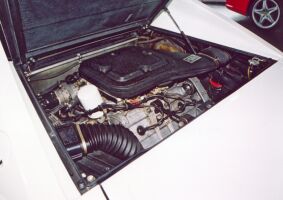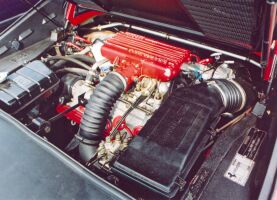This page covers the following models :
308 GT/4
308 GTB
308 GTS
308 GTBi/GTSi
308 GTB/GTS Quattrovalvole
It was this engine which was the main innovation, it being a completely new 90 degree all-alloy V8 with a five-bearing crankshaft and
four (belt-driven) overhead camshafts generating 250bhp. Although not the first time Ferrari had used such an engine configuration, it was the first time such an engine
was mounted transversely and the first time in a GT class car.
The chassis, a standard Ferrari tubular design, was effectively a stretched 246GT one, with the same suspension and braking systems as the latter vehicle.
The rather angluar Bertone design proved quite controvertial and was not universally liked. Two luggage areas were provided,
one at the front, which also contained the spare wheel, and one at the back behind the engine and under a separate lid.
In 1976 the Dino name and logo was dropped, and the car gained Ferrari badging. Several minor changes, including a modified grille, a revised interior design and
the removal of one of the two distributors were also made at this time. Overall it proved a great success, remaining in production
until 1980 with a total of 2,826 examples constructed. See the 208 page for the 2-litre version.
It also saw some use in motorsport, including the 1974 Le Mans 24H where a car was entered by NART (but retired quite early).
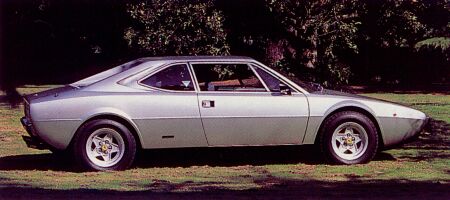 The
first car to use the new 2927cc V8 "308" engine was the Dino 308GT4, introduced
at the Paris Motorshow in 1973. Initially bearing no Ferrari badges, it
was a two-door, 2+2 coupe with a body designed by Bertone (the first Ferrari
to be done by that firm, and the first non-Pininfarina design since 1953) with the engine mounted transversely
behind the occupants.
The
first car to use the new 2927cc V8 "308" engine was the Dino 308GT4, introduced
at the Paris Motorshow in 1973. Initially bearing no Ferrari badges, it
was a two-door, 2+2 coupe with a body designed by Bertone (the first Ferrari
to be done by that firm, and the first non-Pininfarina design since 1953) with the engine mounted transversely
behind the occupants.
Technical Details
| Engine | 2927cc (81x71mm) 90deg V8 dohc (per bank) with 250bhp @ 7,700rpm |
| Suspension | front : double wishbones and coil springs
rear : double wishbones and coil springs wheelbase : 2550mm track (front/rear) : 1470mm/1460mm |
| Brakes | discs all round with servo assistance |
| Transmission | 5 speed manual plus ZF locking differential |
| Empty weight | 1,150kg |
In 1976, after 808 fibreglass-bodied cars had been built,
the bodywork changed to a steel construction, and in September of the following year
the open version or GTS was added. At the same time the Europe-only
dry sump lubrication was deleted, and all cars were fitted with a wet-sump
system. The last few cars also lost some power (230bhp) due to more stringent emission
controls. Production of the original GTB ceased in 1979 by which time a
total of 2,897 examples had been built.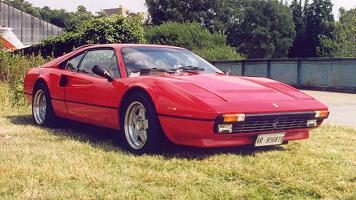 Based around the 308GT4 mechanicals and
replacing the 246GT, at the 1975 Paris Motorshow
Ferrari unveiled their latest two-seater, the 308GTB. This used a shortened
308GT4 chassis, (the same wheelbase as the original
246GT but with increased tracks) and the driveline from the same car, whilst many styling cues were carried on from the 246. For
Europe the engine also adopted dry-sump lubrication. The bodywork, designed
by Pininfarina, was fibreglass (except for the aluminium bonnet) and followed
the style of the recently released 365 GT4 BB (or Boxer).
Based around the 308GT4 mechanicals and
replacing the 246GT, at the 1975 Paris Motorshow
Ferrari unveiled their latest two-seater, the 308GTB. This used a shortened
308GT4 chassis, (the same wheelbase as the original
246GT but with increased tracks) and the driveline from the same car, whilst many styling cues were carried on from the 246. For
Europe the engine also adopted dry-sump lubrication. The bodywork, designed
by Pininfarina, was fibreglass (except for the aluminium bonnet) and followed
the style of the recently released 365 GT4 BB (or Boxer).
Technical Details
| Engine | 2927cc (81x71mm) 90deg V8 dohc (per bank) with 255bhp @ 7,700rpm (240bhp in USA) |
| Suspension | front : double wishbones and coil springs
rear : double wishbones and coil springs wheelbase : 2340mm track (front/rear) : 1460mm/1460mm |
| Brakes | ventilated discs all round |
| Transmission | 5 speed manual plus ZF locking diff |
| Empty weight | 1,090kg (firbeglass), 1155kg (steel) |
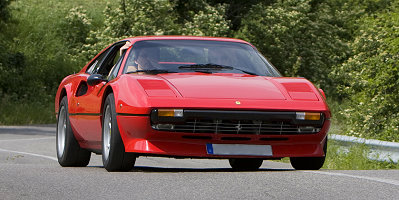 |
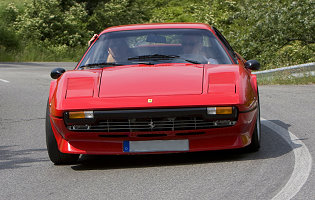 |
As with the GTB, production stopped in
1980 with 3,219 examples produced.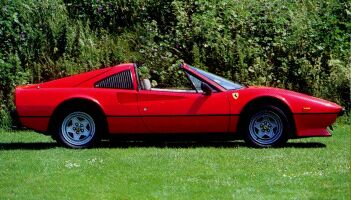 At
about the same time as construction of the GTB moved to using a steel shell,
in 1977 a targa variant, the GTS was introduced, unveiled at the Frankfurt
Motorshow of that year. This had some additional strengthening to compensate
for the loss of the roof, the latter being replaced by a composite removable panel
which could be placed behind the seats when not fitted. The rear quarter
windows were also covered with black louvred panels.
At
about the same time as construction of the GTB moved to using a steel shell,
in 1977 a targa variant, the GTS was introduced, unveiled at the Frankfurt
Motorshow of that year. This had some additional strengthening to compensate
for the loss of the roof, the latter being replaced by a composite removable panel
which could be placed behind the seats when not fitted. The rear quarter
windows were also covered with black louvred panels.
Technical Details
as for the GTB except
| Empty weight | 1,380kg |
In 1980 the engines in both the GTB and
GTS received a Bosch K-Jetronic fuel injection system and a Marelli Digiplex
electronic ignition. The power of these 'emissionised' engines dropped
to 214bhp (in Europe and 208bhp in the USA) and the designations changed
to GTBi and GTSi respectively. A few other minor details were also revised, such as the instrument panel and stering wheel becoming black (previously they
were silver), different door mirrors and seats.
Production continued for only two years,
with 494 GTBi's and 1,749 GTSi's being built.
This model was also used with some success
in rallying, more details here.
Technical Details
as for the GTB/GTS except
| Engine | 2927cc (81x71mm) 90deg V8 dohc (per bank) with 214bhp @ 7,700rpm |
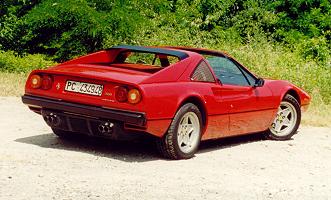 At
the Paris Motorshow in 1982 a new model was unveiled, in which the engines
received an increase in power output (up to 240bhp). This was achieved principally through the adoption
of four-valves-per-cylinder (hence the QV designation), although other details also changed, such as the adoption of new aluminium cylinder liners. Other
changes included the addition of an air duct across the bonnet to improve
the flow of air through the radiator, and a new grille featuring a prancing horse and additional driving lights on
each side. Production continued until they
were replaced by the 328 in 1985. There were 748
GTB QV's and 3,042 GTS QV's built.
At
the Paris Motorshow in 1982 a new model was unveiled, in which the engines
received an increase in power output (up to 240bhp). This was achieved principally through the adoption
of four-valves-per-cylinder (hence the QV designation), although other details also changed, such as the adoption of new aluminium cylinder liners. Other
changes included the addition of an air duct across the bonnet to improve
the flow of air through the radiator, and a new grille featuring a prancing horse and additional driving lights on
each side. Production continued until they
were replaced by the 328 in 1985. There were 748
GTB QV's and 3,042 GTS QV's built.
Technical Details
as for GTB/GTS except
| Engine | 2927cc (81x71mm) 90deg V8 dohc (per bank) with 240bhp @ 7,000rpm |
| Empty weight | GTB QV : 1,275kg
GTS QV : 1,286kg |
See our picture gallery index for images from museums, motorshows and events.
There are also wallpapers/desktop backgrounds available to download.
Use the buttons at the top to navigate further, or
Copyright © 2000 to 2011 CarsfromItaly
